Southwest Wawa is three years old! Thank you to everyone who has supported and subscribed. We’ve grown into a community of almost 600 people in that time. A lot has changed in that time; projects have finished and even more projects have started. In a couple of weeks, I’ll be graduating from the Institute of American Indian Arts with an MFA in Creative Writing. I never thought I’d go to school for art and get an MFA like my dad, but I guess you really never know what’s going to happen next. The writing may have slowed here, but I can’t wait to share what’s been happening in the background. You can look forward to Southwest Wawa getting back on a monthly publishing cycle after this issue.
From the last time we chatted, a couple of things I’ve been working on have opened! One being the following. For a couple of months, I’ve been working with the Pacific Science Center to refresh an exhibit based on a tree slice or ‘tree cookie’ as I learned they say in the children's science world. Initially, the tree cookie was showcased during the 1962 World’s Fair. A Douglas Fir (sčəbidac) from the area was sliced and highlighted, the World’s Fair curators determined that the fir was 631 years old. The Science Center wanted to refresh the exhibit because it was a bit dated, to say the least. To highlight the drastic growth, someone from the World’s Fair placed plaques in the shape of arrows to highlight a specific ring and a corresponding date.
e.g
Tree Cut in Seattle - 1962 →
Founding of Seattle - 1851 →
Declaration of Independence 1776 →
Once the Science Center inherited the tree cookie from the World’s Fair, they were able to bring in the importance of studying trees and growth rings. They talk about environmental stressors like fires, volcanoes, tsunamis, and earthquakes. I chuckled when I saw a huge crack in the growth ring at the same time that the pilgrims landed across the country. Maybe you gotta add social stressors too.
I had proposed the idea of moving away from the colonial and literally linear way of using the tree cookie like this and imagined how we can think of the growth rings like cycles, because they literally are. We shouldn’t think of the fir’s demise in 631 years but rather the graciousness of 631 cycles that the fir witnessed. Six hundred and thirty-one summers of salmon, falls of mushrooms, winters of storytelling, and springs of camas blooms. So, as a collaboration, we refreshed the exhibit into Rooted in Time: Cycles of the Salish Sea. Visitors can observe the yearly cycles of sčəbidac (we obviously had to include the twulshootseed name for Douglas Fir, the species was only named after D. Douglas in 1833) and begin to construct their own seasonal calendar in regard to the activities they do with their family. Like going over to relatives' houses in the fall, drinking hot chocolate in the winter, going to bumbershoot in the summer. People also are able to bring in their own cultural values to the board.
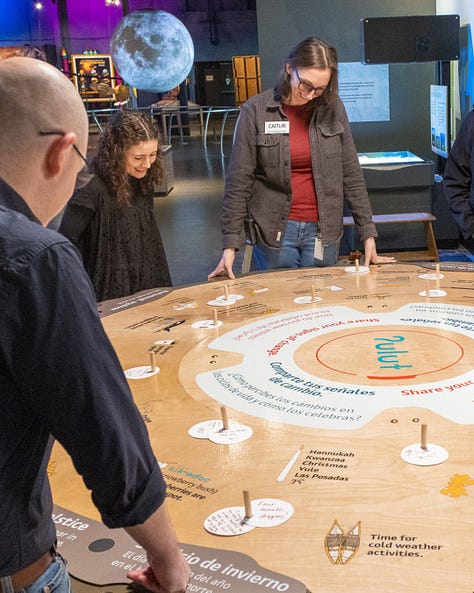
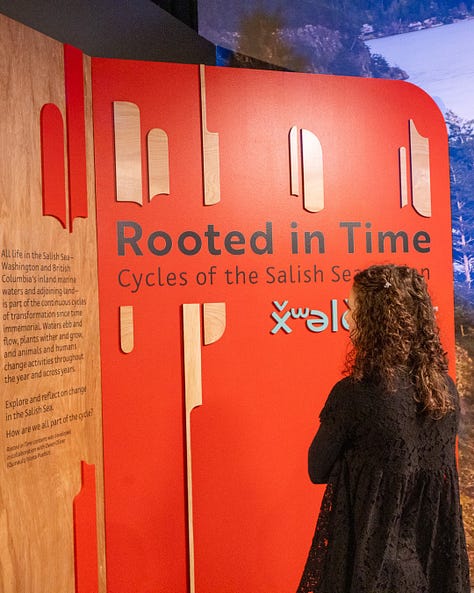
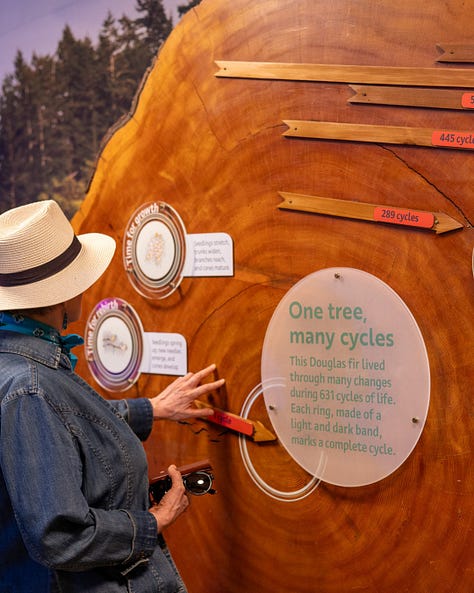
Come check out Rooted in Time today! Remember all Indigenous people receive free admission to the Pacific Science Center.
It seems like every issue I could write about the Seattle Waterfront. Honestly, stuff is always changing down there and new art, plants, and signage is popping up. At least the Aquarium is done! In Southwest Wawa issue 29, I talked a bit about the artwork I helped install on the Overlook Walk (the rooftop of the new Seattle Aquarium). It adds to the story of collecting clams and weaving baskets as a dialogue with the shoreline before contact. Check it out if you haven’t.
Down the waterfront in front of the Coleman Dock, two new way-finding signs have been installed. Here on Southwest Wawa we love way-finding and the little elements that indigenize a city. Of course we need the systemic change and more large public art but it’s quite a pleasure to just be walking through the city and see more lushootseed being added.

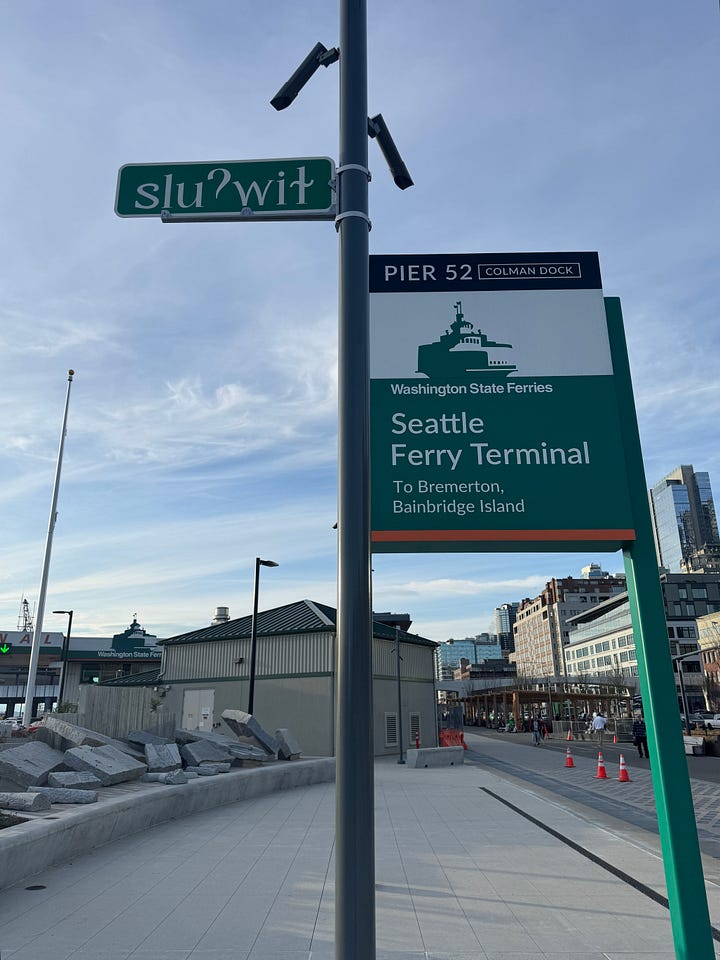
Muckleshoot and Suquamish were asked to bring forward two words that they wanted represented in this space. They brought forth ʔuluɬali and sluʔwiɬ.
ʔuluɬali meaning to travel by water (canoe)
sluʔwiɬ meaning to bring a canoe through a passage / hole
(There are multiple ways to pronounce these words due to the variety of lushootseed dialects in the region. They don’t change a lot but sometimes the sounds of ‘u’ can change)
These are perfect for the ferry dock and for the shoreline. I really enjoy that there isn’t a translation for them and they are just existing. Also here, it’s so important that they are in the lushootseed phonetics, they aren’t just english trying to be lushootseed. I knew that other people would have different opinions so after I saw these signs, I went to Facebook and looked through the comment section of the WSF post.
why are we now posting signs in foriegn [sic] languages???!?? Should be in ENGLISH (with foriegn language subtitle... maybe)....
Well ... its seattle, idgits run the place.....
And somehow I can’t read this one without Trump’s voice,
Great to honor the Indians but nobody knows how to pronounce this. Bad choice. Will cause confusion.
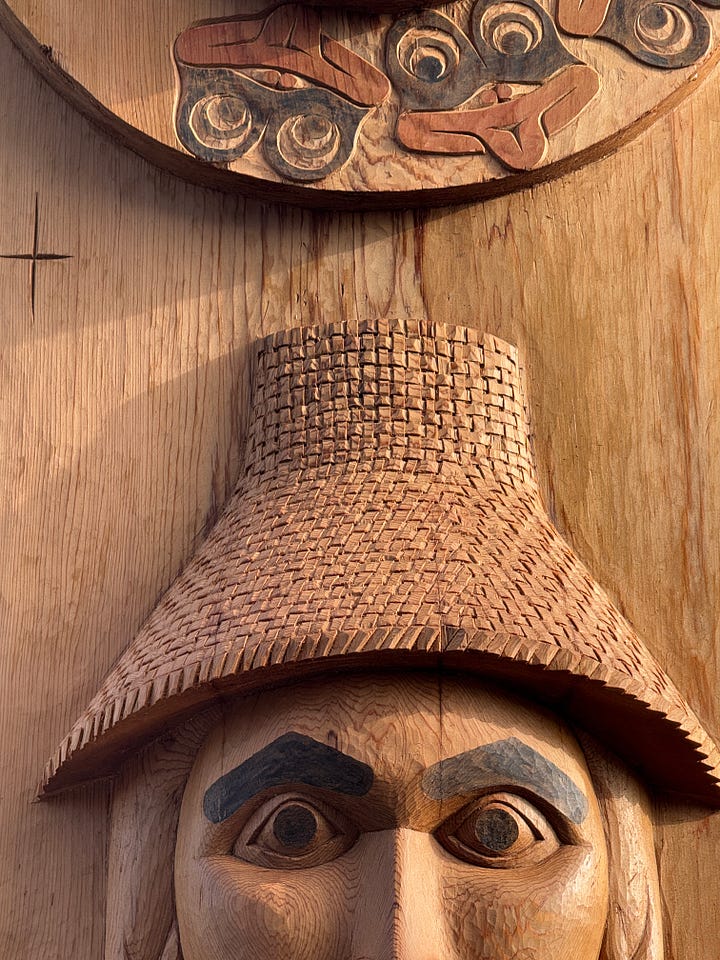



Lastly, I wanted to share a couple of books I’ve really been enjoying. First, David B. Williams just released Wild in Seattle: Stories at the Crossroads of People and Nature. David has been a great friend over the past couple of years. I first read his work in an environmental class at the University of Washington. I was a bit starstruck when our paths eventually crossed. Wild in Seattle is a collection of 40 essays that dive into the natural landscape. My favorite essay is on the Coast Salish Woolly Dog. You may be familiar with some of the stories from David’s Substack “Street Smart Naturalist” but the book is filled with beautiful watercolors by Elizabeth Person and new side notes. I know that Wild in Seattle is going to be on my list for gifting newcomers to Seattle. You can purchase Wild in Seattle in Pacific Northwest Bookstores or directly from David.
Another book that is already dog-eared and filled with dozens of Post-it notes is Living-Off-The-Land for 4,000 years on the Salish Sea by Ed Carriere and Dale Croes. For those who don’t know, Ed Carriere is a world-renowned basketmaker from the Suquamish Tribe. He is a powerful knowledge holder and elder in our Coast Salish communities. He grew up around a family that had intimate knowledge of the land before contact. His Great-Grandmother, Julia Jacobs, grew up in Old Man House and shared those stories and teachings with Ed. This is the second book that Ed and Dale have collaborated on as a way to link Indigenous knowledge systems as archaeology and vice versa. The book goes into detailed recollections of how Ed grew up “living off the land” through the flora and fauna of the Salish Sea. It’s hard not to be hungry when reading this book because Ed is telling about all the ways that you can cook up shellfish, fish, ducks, and berries. If you are interested in learning more about the Coast Salish knowledge systems and the flora and fauna around the Salish Sea, I would highly encourage you to check out Living-Off-The-Land for 4,000 years on the Salish Sea. It’s the real deal.
Below I’ve linked to a video that NEA made after Ed Carriere was awarded a National Heritage Fellowship. The video is phenomenal.




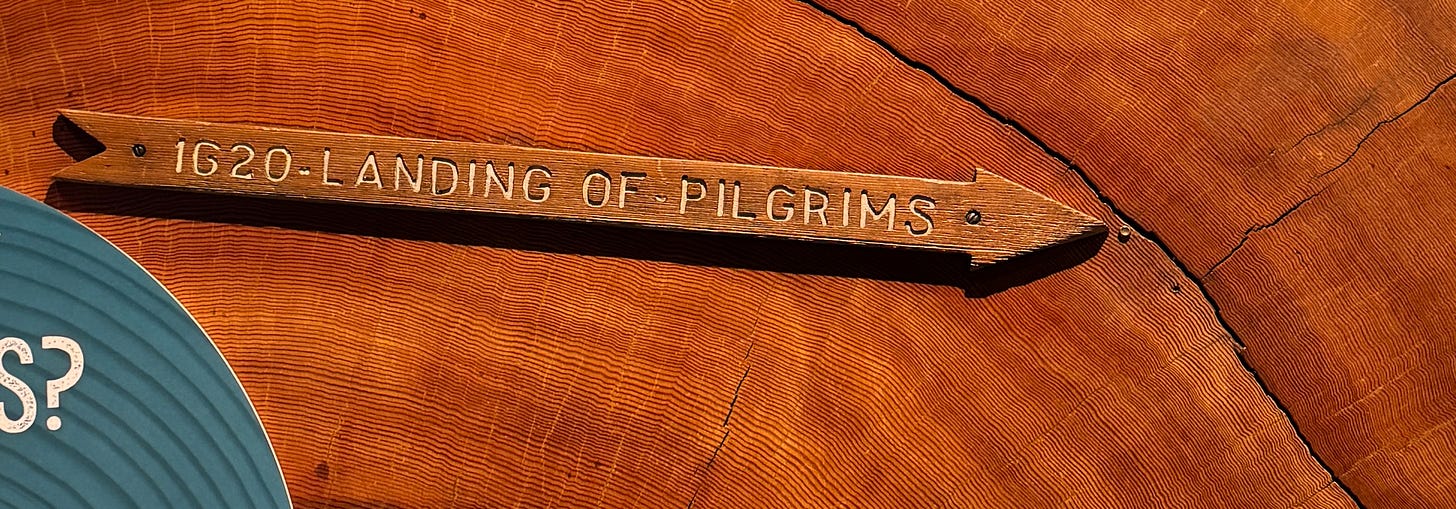




![Generationally-Linked Archaeology: Living-Off-The-Land for 4,000 Years on the Salish Sea [Book] Generationally-Linked Archaeology: Living-Off-The-Land for 4,000 Years on the Salish Sea [Book]](https://substackcdn.com/image/fetch/$s_!tCXO!,w_1456,c_limit,f_auto,q_auto:good,fl_progressive:steep/https%3A%2F%2Fsubstack-post-media.s3.amazonaws.com%2Fpublic%2Fimages%2Fd13e3797-76cf-48c2-9962-20ec56de869f_1000x1293.jpeg)
Congrats on your MFA completion and thank you for doing so well in the medium of the short essay format with photos. I've always thought that you and David Williams were "cut from the same cloth," with an abundance of curiosity, integrity, and keen observations on nature, history and culture. Also, you both have a deep humility. No need to shout (usually). Your words land passion are evident.
Wow, I can't wait to go see the sčəbidac Rooted in Time exhibit. And, of course, thanks for the shoutout and kind words about Wild in Seattle.